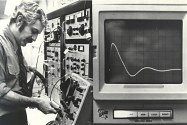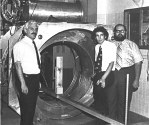| TIMELINE
of MRI |
|||
 |
Dr. Damadian with his post-doctoral research fellows, L.Minkoff and M. Goldsmith, and first MR scanner, Indomitable... |
 |
 First MR scan (image) of the human body, a cross-section of Minkoff's chest near the level of T7/8. Completed 4:45 a.m., July 3, 1977 |
| Dr. Damadian makes original discovery that makes MR scanning possible | ...The team built Indomitable at Downstate in the former animal labs across from B5-302. | ||
1969
Original Concept
Damadian
Conceives of and proposes whole body MR scanner for the first time.(Doc:30,30a)
1970
Key Discovery Makes MR Scanner Possible
Damadian
identifies T1/T2 differences between cancer and normal. He was seeking
an MR signal difference in an important disease (cancer) that would prove
his idea of an MR body scammer was a goal worth pursuing. Submits paper
(Doc:1,1a)
March/71
First
Published Article
Damadian
T1/T2 findings and scanner proposal published in Science, March
19, 1971. High pixel contrast provided by dramatic T1/T2 differences overcomes
x-ray's century-old inability to see detail in vital organs. (Doc;1,1d,1c)
Spring/71
Scanning
Method Proposed
Damadian outlines voxel-by-voxel scanning method. (Doc:6,6c;
Doc:4,4a)
Sept./71
Gradient Method
Proposed
Lauterbur notebook proposal of gradient methods of Gabillard,
Purcell & Carr for 1-dimension (incomplete) scan method. (Doc:3.1,
22, 40)
March/72
First
Patent Filed
Damadian files '832 patent for 3-dimension voxel-by-voxel scan method
and T1/T2 method. Issued in '74. (Doc: 7, 30a,
20.1, 20.1a, 45)
March/72
2D
Scan (Image) Achieved
Lauterbur
submits 2-dimension MR scan (image) method with scan of 1mm tubes for
publication (Doc: 5, 5a)
March/73
2D
Paper Published
Lauterbur paper published in Nature, March 16, 1973
(Doc:5, 5b)
1974
3D Scan Method Proposed
Garroway, Grannell & Mansfield publish 3-dimension scan method*
1975
Phase Coding Introduced
Kumar, Welti & Ernst introduce phase encoding to scan method.**
1977
First
Human Scan Achieved
Damadian
and coworkers, Minkoff and Goldsmith, achieve first scan (image) of the
human body utilizing voxel method of patent. (Doc: 17,
17.5, 26, 27,
46)
1980
Phase
Coding Applied
Aberdeen
group introduces spin warp method***
1980
First
Commercial MRI
Damadian
and FONAR introduce first commercial MRI scanner utilizing voxel method
of patent.
1997
Patent
Upheld
High
Court on U.S. Patents and U.S. Supreme Court enforce Damadian '832 patent.
(Doc:43)
Document:
30, 30a
Health Research Council of the City of New York --- Damadian's request
to the Health Research Council of the City of New York proposing the MR
(NMR) body scanner and requesting the funds to pursue it. (“Pioneers
of NMR and MR…Bar Ilan Univ. Press, 1996, Chapt. 8, pg A3)
Document:
1,1a --- Science 1971
Damadian submits manuscript to Science on Oct. 12, 1970 reporting his
June 1970 discovery of the large tissue relaxation differences in cancer.
(Science 171 (1971) pg 1153)
Document:
1,1d,1c--- Science 1971
Damadian's T1/T2 findings in cancer and normal tissues published, and
x-ray's soft tissue contrast deficiency identified by him as problematic
in medicine for cancer detection. The prospect of overcoming that deficiency
using the MR (NMR) together with the tissue relaxation to detect cancers
by apparatus external to the body is proposed. (Science 171 (1971) pg
1151-1153)
Document:
6, 6c
State University of New York (SUNY) periodical, Downstate Reporter, publishes
Damadian relaxation discovery, his intention to build a body scanner based
on it, and his first proposal of a 3D voxel-by-voxel scanning method obtained
by passing the patient back and forth across the magnet. (“Pioneers
of NMR and MRI…Bar Ilan Univ. Press, 1996, Chapt. 8, pg A5)
Document:
4, 4a
Letter from G. Donald Vickers, President Seimco Corporation, former Vice-President
of NMR Specialties Corp. where Damadian performed his original NMR measurements
on cancerous rat tissues. Vickers was also the witness to the Lauterbur
notebook entry of Sept. 1971 (Doc. 3.1b, 3.1c). The letter testifies of
the priority of: Damadian's conceptualization of the NMR body scanner,
the discovery of the relaxation differences to implement the scanner,
and the proposal of his first voxel-by-voxel method for accomplishing
the scan. (“Pioneers of NMR and MRI… Bar Ilan Univ. Press,
1996, Chapt. 8, pg A22, A23)
Document
3.1
Lauterbur notebook entry, witnessed by Lauterbur and Vickers (author of
Doc. 4) recording his proposal of the gradient for spatial discrimination
in one-dimension only (3 dimensional spatial resolution is required for
a scan). The method had been previously published in the 1950's by Gabillard
(Doc. 22) and by Carr and Purcell (Doc.40) for the same purpose (one dimensional
spatial discrimination).
The witnessed Lauterbur notebook entry acknowledges Damadian's priority. (“Pioneers of NMR and MRI…, Bar Ilan Univ. Press, 1996, Chapt. 9, pg B3)
Document
22
Publication of the gradient for 1-dimensional spatial resolution by Gabillard
in 1951. (hebd. Seanc. Acad. Sci. (1951) Paris, 232, 1551-1553; Phys.
Rev. 85 (1952), pg 694-695)
Document
40
Letter to the editor by Herman Carr reports that use of gradient for spatial
discrimination was published in the 1950's prior to Lauterbur's use of
the gradient for the same purpose in 1973. (H.Carr, Phys. Today Jan 1993,
pg 94); H.Y. Carr, EM Purcell, Phys. Rev. 94, 630 (1954))
Document
7
U.S. Patent 3,789,832 (the '832 patent), filed on March 17, 1972 by Damadian
describes the use of the T1 and T2 relaxations as a method for detecting
cancer and provides the first method ever for accomplishing a scan of
the live human body.
The patent also provides the first method ever for a means of achieving the needed 3d spatial localization necessary to accomplish a body scan. It describes the method of using this localization to scan the live human body to detect cancer. The patented scanning method accomplishes the 3D spatial localization of a voxel-by-voxel acquisition by the combined shaping of the static and rf magnetic fields [see Doc. 45, footnote to Doc. 45 and Doc. 20.1].
Document
20.1, 20.1a
1980 Marketing brochure of Oxford Instruments describing the Oxford TMR
(topical magnetic resonance) small animal spectrometer that uses the same
voxel method as the Damadian 1972 patent. The cover is a color graphical
illustration of the saddle-shaped static magnetic field used in the Oxford
TMR spectrometer to achieve spatial localization. The brochure describes
the combined use of shaped ("focussed") static and rf magnetic
fields for spatial localization using means analogous to the Hewlett-Packard
rf "focussing" patent and the Damadian patent. The first use
by Oxford of the method was in 1980 (see-cited references and accompanying
text). (“Topical Magnetic Resonance,” Oxford Research Systems
Ltd.; Nuffield Way, Abingdon Oxfordshire OX14 1Rx, England Cat. No TMR
20, Printed in England 2M/AMSG/682)
Document
45
Hewlett-Packard patent by J. D. Larson (1993) citing Damadian 1972 patent
describes use of rf focussing for accomplishing spatial localization in
MR scans of the human body. (U.S. Patent, 5,185,573, Feb 9, 1993)
Document
5, 5a, 5b
Publication submitted to Nature by Lauterbur in Oct. 1972. The citation
by Lauterbur of Damadian's prior discovery, that was in his private witnessed
notebook (Doc. 3.1, 3.1c), is not included in the publication. (Nature,
London, 242 (1973), pg. 190-191)
Document
17
Publication of the first image of the live human body. (Physiol. Chem.
& Phys. 9 (1977), pg 97-100,108)
Document
17.5
Publication of the first human image in an invited review in Naturwissenschaften.
(Naurwissensehaften 65 (1978) pg 250-252)
Document
26
Notebook entries at the time of the first human scan. (“ Pioneers
of NMR and MRI….Bar Ilan Univ. Press 1996, Chap 8, pg A20-A21)
Document
27
Publication of first scans of patients with cancer. (Physio. Chem. &
Phys. 10, (1978) pg 285-287
Document
46
Report of first
human scans of normal and cancerous patients at the Royal Society in London
in 1979 (Phil. Trans. Royal Society London B289 (1980) pg. 489-500).
Document
43
Decision of the U.S. High Court on Patents in Washington, D.C.
(Court of Appeals for the Federal Circuit) affirmed by the U.S. Supreme
Court. Decision affirms that all MRI scanners make use of the T1/T2 Damadian
discovery by using T1 and T2 to control the brightness of the image pixels
in T1 and T2 images.
(Note: The overwhelming majority of all MRI scans are T1 and T2 images), thereby creating the image contrast needed to detect cancers. (Note: X-ray images are lacking in soft tissue contrast.)
CORPORATE SUMMARY OF VERDICT
On May 27, 1997 the Honorable Wm. H. Rehnquist, Chief Justice, the United States Supreme Court, enforced the Order of the Federal Circuit Court of Appeals and ordered G.E. to pay Fonar. G.E. paid Fonar $128,705,766 for patent infringement. G.E. was further restrained from any use of Fonar technology.
The Court found that G.E. had infringed U.S. Patent 3,789,832, MRI's first patent, which was filed with the U.S. Patent Office in 1972 by Dr. Damadian. The Court concluded that MRI machines rely on the tissue NMR relaxations that were claimed in the patent as a method for detecting cancer, and that MRI machines use these tissue relaxations to control pixel brightness and supply the image contrasts that detect cancer in patients.*
The Court also found infringement of U.S. Patent 4,871,966 concerning a technique of obtaining MRI images at multiple angles.
AFFIRMED
BY THE
UNITED STATES SUPREME COURT
* The patent also
discloses the first ever comparison study of the tissue NMR relaxations
of the normal tissues thus demonstrating for the first time that the discovery
by Dr. Damadian of the dramatic differences in the NMR relaxations of
living tissues disclosed in the patent is true for living tissue in general.
The discovered relaxation differences of both the cancerous and normal
tissues are and integral part of the Court enforced 1972 patent claims
(Claim 1a,1b,1c) establishing standards for the normal tissues and malignant
tissues of the same type. The NMR relaxation differences disclosed in
the patent for normal tissues as well as for cancers are used throughout
MRI imaging to supply and control pixel contrast. The tissue NMR relaxation,
which does not exist in any other imaging modality, provides the exceptional
contrast of MRI (10 to 30 times that of x-ray) and is responsible for
the extraordinary beauty of the MRI image.
*
A.N. Garroway, P.K. Grannell and P. Mansfield
J. Phys. C: Solid State Phys. 7, (1974), L457-462
***
Edelstein, W.A., Hutchinson, JMS, Johnson G.
Redpath T.W. Phys. Med Biol 25:751 (1980)
Alfred Nobel's Will required that the Nobel Prize in Medicine or Physiology be given for "discovery" only. This is different than the Nobel Prize in Physics which is given for "discovery or invention" and the Nobel Prize in Chemistry which is given for "discovery or improvement"
Below is the exact wording of part of the translation into English of Alfred Nobel's will, which was signed in Paris on 27 November 1895.
" The whole of my remaining realizable estate shall be dealt with in the following way: The capital shall be invested by my executors in safe securities and shall constitute a fund, the interest on which shall be annually distributed in the form of prizes to those who, during the preceding year, shall have conferred the greatest benefit on mankind ... ; one part to the person who shall have made the most important discovery within the domain of physiology or medicine; ... The prizes for ... shall be awarded by ... that for physiology or medicine by the Carolinska Institute in Stockholm; ... ''
http://www.nobel.se/medicine/articles/lindsten-ringertz-rev/